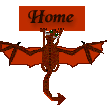|
2.4. Greek and Roman Dragon Myths
Greece and Rome both have many examples of dragons in their mythology, probably due to the large pantheon of Gods and Godesses both cultures had. First will be the Greek dragons, the the Roman.
Greece has many wonderful examples of dragons to list. Some of the earliest Western dragons, many are fierce, horrifying creatures. However, the Greeks believed that they were able to understand and teach mortal men the knowledge of the earth. Being so deadly and wise, dragons were frequently used as military symbols. Greek dragons appeared to be Guardian Dragons of tremendous proportions. Generally speaking, they were not where they were by their own choice. The Gods and Godesses used dragons ruthlessly, to further plans or to guard treasures. As always, though, there are a few exceptions. Doing something wrong could get a human turned into a dragon-like creature as punishment. But mostly, Greek dragons had a purpose.
Typhon
Also known as: Typhaon, Typhoeus
The son of Gaia and Tartarus, he had a hundred dragon heads and scaled legs and thighs. He was taller than mountains, had wings, and breathed fire. It was sometimes said that his body was covered in feathers, but at other times, myth said his body was all snakes. Typhoons are named after him. Once, he attacked Zeus and capture him. The king of the gods had to be rescued by Hermes and Pan. After he was freed, Zeus imprisoned Typhon. Some myths say he was trapped in Tartarus and others tell that he was placed under Mt. Aetna. It was believed that he was the cause of dangerous winds and earthquakes. He sired the Chimaera, the Lernean Hydra, Cereberus(Cerberus), the Nemean Lion, and the Sphinx. The mother of all those monsters was Typhon's sister, Echidna.
Lernean Hydra
From the water dragon species that lived in the swamp of Lerna in Argolis, it was said to have nine heads, one of which was immortal and could not be harmed by any weapon. In addition to that problem, for each of the other heads you cut off two more grew in it's place. (Some myths simply say that it regrew the missing head immediately.) It's venom was lethal, and it's blood was poisonous. The stench from it's breath was just as deadly as it's venom. It was huge, standing at least twice the height of Hercules himself. It would rise from the swamp to slay men and cattle to feed itself. Hercules was told to kill the beast as one of the legendary tasks. First, he drew it from it's lair with fiery arrows, then began to wrestle with the heads. He called on his young companion, Iolaus, for help. Naturally unsure of what to do, he waited a couple seconds. He then realized that Hurcules was losing, and without thinking, Iolaus grabbed a torch and began to burn the places where the heads were as Hercules cut the heads off. This worked to keep the mortal heads from coming back, but could not stop the immortal one. Hercules then cut the immortal head off and buried it beneath a rock where, according to myth, it is alive today. However, it was decided that Hercules could not count that as one of his ten labors, because Iolaus had helped.
Scylla
Also known as: Skylla
Scylla was once a beautiful nymph who brushed off the attentions of a suitor. This suitor ran to Circe, who also loved the suitor, and told her about his hopeless attempts to get the gorgeous nymph. Circe became jealous of Scylla, and chose to take revenge on the nymph. She filled the sea Scylla was swimming in with serpents, and used magic to change her into a sea-monster with six heads and a ring of howling dogs at her waist. Unable to show her face(s) Scylla hid in a cave in the strait of Messina. In order to eat, she captures sailors as they go past.
Coming soon, I'm still researching these myths. Check back.

Back to Dragon Myths

Images by:
 and

|
